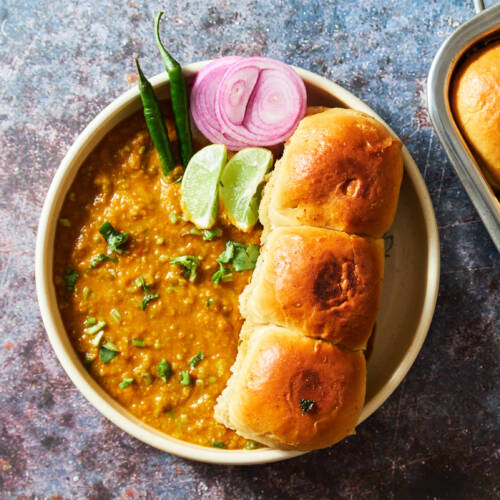Pav Bhaji: Exploring the Culinary Heritage and Cultural Significance of India’s Beloved Street Food

Introduction: In the bustling streets of Mumbai, amidst the cacophony of sounds and aromas, there exists a culinary delight that has captured the hearts and palates of millions – Pav Bhaji. This iconic street food, with its medley of spicy vegetables, buttery pav (bread rolls), and tantalizing spices, is more than just a snack; it’s a cultural phenomenon deeply rooted in the history and ethos of the city. Join us on a flavorful journey as we unravel the origins, cultural significance, and intricacies of the Pav Bhaji recipe, a symbol of Mumbai’s vibrant street food culture.
Origins and Cultural Significance: Pav Bhaji traces its origins to the streets of Mumbai, formerly known as Bombay, where it emerged as a popular street food option in the late 19th century. The dish was initially created as a quick and filling meal for mill workers and laborers, who needed a hearty and affordable lunch option during their busy workdays.
Legend has it that Pav Bhaji was invented by street vendors who repurposed leftover vegetable curry (bhaji) from restaurants and served it with buttered pav bread, creating a flavorful and satisfying meal. Over time, Pav Bhaji evolved from a humble sustenance food to a beloved street food delicacy, beloved by people from all walks of life.
Today, Pav Bhaji holds a special place in Mumbai’s culinary landscape, symbolizing the city’s spirit of resilience, diversity, and innovation. It is not just a snack but a cultural institution, enjoyed by locals and tourists alike, and served at street stalls, restaurants, and even upscale eateries across the city.
Recipe and Preparation: The preparation of Pav Bhaji is a culinary art form that requires skill, precision, and a harmonious blend of spices and ingredients. While there are countless variations of the recipe, each chef adding their unique touch, we present a traditional Pav Bhaji recipe that captures the essence of this beloved dish.
Ingredients: For the Bhaji:
- Potatoes: 4 medium, boiled and mashed
- Cauliflower: 1 cup, finely chopped
- Green peas: 1/2 cup
- Carrots: 1/2 cup, finely chopped
- Capsicum (bell pepper): 1/2 cup, finely chopped
- Tomatoes: 2 large, finely chopped
- Onion: 1 large, finely chopped
- Ginger-garlic paste: 2 tablespoons
- Green chilies: 2-3, finely chopped
- Pav Bhaji masala: 2 tablespoons
- Turmeric powder: 1/2 teaspoon
- Red chili powder: 1 teaspoon
- Salt: to taste
- Butter: 4 tablespoons
- Fresh coriander leaves: for garnish
- Lemon wedges: for serving
For Serving:
- Pav (bread rolls): 8
- Butter: for grilling the pav
- Onion: finely chopped, for garnish
- Fresh coriander leaves: for garnish
- Lemon wedges: for serving
Instructions:
- Heat butter in a large pan or kadhai over medium heat. Add chopped onions and sauté until translucent.
- Add ginger-garlic paste and green chilies to the pan and sauté for a few minutes until aromatic.
- Add chopped tomatoes to the pan and cook until they turn soft and mushy.
- Add chopped vegetables (potatoes, cauliflower, peas, carrots, and capsicum) to the pan and mix well.
- Add turmeric powder, red chili powder, and Pav Bhaji masala to the pan. Mix until the vegetables are well coated with the spices.
- Using a potato masher or a ladle, mash the vegetables while cooking to achieve a smooth consistency.
- Cook the Bhaji mixture for 15-20 minutes, stirring occasionally, until the vegetables are cooked through and the flavors are well blended.
- Once the Bhaji is cooked, add salt to taste and mix well.
- In a separate pan, heat a little butter and lightly toast the pav bread rolls until golden brown and crisp.
- To serve, place a generous serving of Bhaji on a plate, garnish with chopped onions, fresh coriander leaves, and a lemon wedge. Serve hot with buttered pav bread rolls on the side.
Conclusion: In conclusion, Pav Bhaji is more than just a dish; it’s a slice of Mumbai’s vibrant street food culture and a testament to the city’s culinary ingenuity. From its humble origins as a mill worker’s meal to its status as a beloved street food delicacy, Pav Bhaji embodies the spirit of Mumbai – bustling, diverse, and flavorful. So, the next time you find yourself in the bustling streets of Mumbai, don’t miss the opportunity to savor a plate of piping hot Pav Bhaji, and experience the magic of this iconic street food firsthand.




